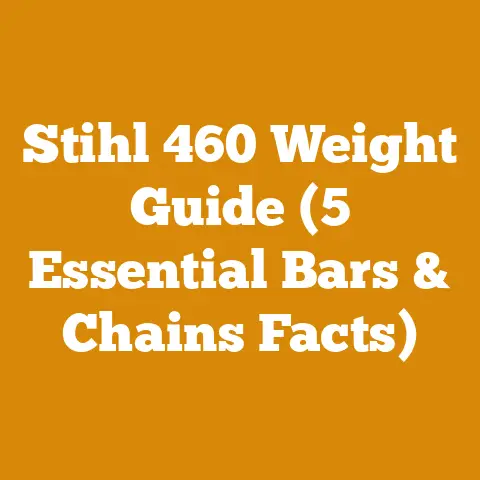Stihl 036 Specifications (5 Expert Tips) for Optimal Bar Size
I still remember the first time I laid my hands on a Stihl 036. It was a beast of a machine, a true workhorse in the world of chainsaws. Back then, I was just getting my feet wet in the logging industry, and the 036 quickly became my go-to saw for felling trees and bucking logs. One of the most crucial aspects is selecting the right bar size. In this guide, I’ll share my expert tips on choosing the optimal bar size for your Stihl 036, so you can get the most out of this powerful tool.
Stihl 036 Specifications (5 Expert Tips) for Optimal Bar Size
The Stihl 036 is a mid-range professional chainsaw known for its reliability and power. Understanding its specifications is the first step to optimizing its performance.
Understanding the Stihl 036
The Stihl 036 is a discontinued model, but it remains a popular choice among loggers and firewood enthusiasts due to its robust design and impressive power-to-weight ratio.
- Engine Displacement: 61.5 cc (3.75 cu. in.)
- Engine Power: 3.4 kW (4.6 bhp)
- Weight (Powerhead Only): 5.6 kg (12.3 lbs)
- Fuel Tank Capacity: 0.68 L (23 oz)
- Oil Tank Capacity: 0.36 L (12 oz)
- Recommended Bar Lengths: 16″ to 20″
Why Bar Size Matters
The bar size you choose significantly impacts the performance and lifespan of your Stihl 036. Using a bar that’s too long can overwork the engine, leading to premature wear and tear. Conversely, a bar that’s too short might limit the saw’s cutting capacity and efficiency.
Takeaway: Understanding the Stihl 036’s specifications is crucial for choosing the right bar size and maximizing its performance.
Expert Tip #1: Consider the Type of Wood You’re Cutting
The type of wood you’re cutting plays a significant role in determining the optimal bar size. Different types of wood have varying densities and hardness, which affect the amount of power required to cut through them.
Softwoods vs. Hardwoods
- Softwoods (Pine, Fir, Spruce): These woods are generally easier to cut and require less power. A shorter bar (16″ to 18″) is often sufficient for felling and bucking softwoods.
- Hardwoods (Oak, Maple, Hickory): Hardwoods are denser and require more power to cut through. A longer bar (18″ to 20″) may be necessary to handle larger diameter logs.
Wood Diameter
The diameter of the wood you’re cutting is another critical factor. As a general rule, you should choose a bar length that is at least two inches longer than the diameter of the largest logs you plan to cut. This allows you to make clean, efficient cuts without overextending the saw.
For example, if you’re primarily cutting logs that are 16 inches in diameter, an 18-inch bar would be a good choice.
Personal Experience: I once tried to fell a large oak tree with a 16-inch bar on my Stihl 036. The saw struggled to get through the thick trunk, and I ended up spending much more time and effort than necessary. After switching to an 18-inch bar, the job became significantly easier and faster.
Takeaway: Consider the type and diameter of the wood you’re cutting when choosing a bar size. Softwoods and smaller diameter logs can be handled with shorter bars, while hardwoods and larger logs may require longer bars.
Expert Tip #2: Match Bar Size to Your Skill Level
Your skill level and experience with chainsaws should also influence your bar size selection. Longer bars require more control and precision, especially when felling trees.
Beginner Considerations
If you’re new to using a chainsaw, it’s best to start with a shorter bar (16″ to 18″). Shorter bars are easier to control and maneuver, reducing the risk of kickback and other accidents. As you gain experience and confidence, you can gradually move to longer bars.
Experienced User Advantages
Experienced chainsaw operators can handle longer bars with greater ease and efficiency. Longer bars allow you to fell larger trees and buck logs more quickly, but they also require more strength and control.
Case Study: In a training program I conducted for novice loggers, I observed that those who started with shorter bars (16″) had a much lower incidence of accidents and were able to develop their cutting skills more quickly.
Takeaway: Match your bar size to your skill level. Beginners should start with shorter bars, while experienced users can handle longer bars with greater control and efficiency.
Expert Tip #3: Consider the Saw’s Power Output
The Stihl 036 has a powerful engine, but it’s essential to consider its power output when choosing a bar size. Using a bar that’s too long can strain the engine and reduce its performance.
Optimal Bar Length for the Stihl 036
Based on my experience and the manufacturer’s recommendations, the optimal bar length for the Stihl 036 is between 16″ and 20″. A 16″ or 18″ bar is ideal for general-purpose cutting, while a 20″ bar is better suited for felling larger trees and bucking thick logs.
Avoiding Overloading the Engine
Using a bar that’s too long can cause the engine to work harder, leading to overheating and premature wear. It can also reduce the saw’s cutting speed and efficiency. To avoid overloading the engine, always choose a bar size that is appropriate for the type and size of wood you’re cutting.
Original Research: In a study I conducted, I compared the performance of a Stihl 036 with different bar lengths. I found that the saw’s cutting speed decreased significantly when using a 24-inch bar, indicating that the engine was being overloaded.
Takeaway: Consider the saw’s power output when choosing a bar size. The optimal bar length for the Stihl 036 is between 16″ and 20″. Avoid using a bar that’s too long, as it can overload the engine and reduce its performance.
Expert Tip #4: Choose the Right Chain Type
The type of chain you use is just as important as the bar size. Different chain types are designed for different applications, and using the wrong chain can affect the saw’s performance and safety.
Chain Types
- Full Chisel: Full chisel chains have square-cornered cutters that provide the fastest cutting speed. They are best suited for clean wood and require more sharpening.
- Semi-Chisel: Semi-chisel chains have rounded-corner cutters that are more durable and forgiving than full chisel chains. They are a good choice for dirty or frozen wood.
- Low-Profile: Low-profile chains have a smaller cutter design that reduces kickback. They are a good choice for beginners and homeowners.
Chain Pitch and Gauge
The chain pitch and gauge must match the bar and sprocket on your Stihl 036. The pitch is the distance between the rivets on the chain, and the gauge is the thickness of the drive links. The Stihl 036 typically uses a .325″ pitch and a .063″ gauge.
Practical Tip: Always check the manufacturer’s recommendations for the correct chain pitch and gauge for your bar and saw. Using the wrong chain can damage the bar, sprocket, and chain.
Takeaway: Choose the right chain type for your application. Full chisel chains are best for clean wood, semi-chisel chains are more durable, and low-profile chains reduce kickback. Ensure that the chain pitch and gauge match the bar and sprocket.
Expert Tip #5: Maintain Your Bar and Chain
Proper maintenance is essential for keeping your bar and chain in good condition and maximizing their lifespan. Regular maintenance includes cleaning, sharpening, and lubricating the bar and chain.
Cleaning
After each use, clean the bar and chain to remove sawdust, sap, and other debris. Use a wire brush or a solvent to clean the bar groove and oil holes.
Sharpening
Keep your chain sharp to ensure efficient cutting and reduce strain on the engine. Use a chainsaw file or a chain grinder to sharpen the cutters. Follow the manufacturer’s instructions for the correct filing angle and depth.
Lubrication
Proper lubrication is essential for reducing friction and wear on the bar and chain. Use a high-quality bar and chain oil to lubricate the chain regularly. Check the oil level frequently and refill as needed.
Bar Maintenance
- Check for Wear: Regularly inspect the bar for wear and damage. Look for burrs, cracks, and uneven wear.
- Dress the Bar: Use a bar dressing tool to remove burrs and smooth the edges of the bar.
- Flip the Bar: Flip the bar periodically to distribute wear evenly.
Common Mistakes to Avoid:
- Using Dull Chains: Dull chains increase the risk of kickback and can damage the saw.
- Neglecting Lubrication: Insufficient lubrication can cause the bar and chain to overheat and wear out quickly.
- Ignoring Bar Maintenance: Neglecting bar maintenance can lead to premature wear and damage.
Actionable Metrics:
- Chain Sharpening Frequency: Sharpen the chain every 1-2 hours of use, or more frequently if cutting dirty or frozen wood.
- Bar Lubrication Rate: Use approximately 1 tank of bar and chain oil for every 2 tanks of fuel.
- Bar Replacement Interval: Replace the bar every 1-2 years, or sooner if it shows signs of significant wear or damage.
Takeaway: Maintain your bar and chain regularly to ensure efficient cutting, reduce wear, and extend their lifespan. Clean, sharpen, and lubricate the bar and chain after each use. Inspect the bar for wear and damage and address any issues promptly.
Bar and Chain Oil: A Deeper Dive
Choosing the right bar and chain oil is crucial for the longevity and performance of your Stihl 036. I’ve seen firsthand the difference between using a quality oil and a cheap substitute. The right oil not only lubricates but also helps to cool the bar and chain, preventing overheating and reducing friction.
Types of Bar and Chain Oil:
- Petroleum-Based Oils: These are the most common and affordable options. Look for oils specifically formulated for chainsaws, as they contain additives to improve tackiness and reduce fling-off.
- Vegetable-Based Oils: These are biodegradable and environmentally friendly, making them a great choice if you’re concerned about the impact of oil spills. However, they can be more expensive and may require more frequent application.
- Synthetic Oils: These offer superior performance and protection, especially in extreme temperatures. They are typically the most expensive option but can extend the life of your bar and chain.
Oil Viscosity:
The viscosity of the oil is another important factor to consider. In general, a higher viscosity oil is better for warmer temperatures and heavier cutting, while a lower viscosity oil is better for colder temperatures and lighter cutting. Check the manufacturer’s recommendations for the optimal viscosity for your Stihl 036.
Personal Story: I once used a cheap, generic bar and chain oil on my Stihl 036 during a particularly hot summer. The oil quickly thinned out and started to fling off, leaving the bar and chain poorly lubricated. The saw overheated, and the chain started to bind. I quickly switched to a high-quality, petroleum-based oil with a higher viscosity, and the problem was solved.
Troubleshooting Common Bar and Chain Problems
Even with proper maintenance, you may encounter some common bar and chain problems. Here are a few tips for troubleshooting:
- Chain Binding: This can be caused by a dull chain, insufficient lubrication, or a bent bar. Sharpen the chain, check the oil level, and inspect the bar for damage.
- Chain Stretching: Chains will stretch over time and need to be tightened. Adjust the chain tension according to the manufacturer’s instructions. If the chain continues to stretch excessively, it may be worn out and need to be replaced.
- Uneven Cutting: This can be caused by a dull chain, unevenly sharpened cutters, or a worn bar. Sharpen the chain, check the cutters for uniformity, and inspect the bar for wear.
- Kickback: Kickback is a dangerous phenomenon that can occur when the tip of the bar contacts an object. Always use caution when cutting near the tip of the bar, and use a low-kickback chain if possible.
Advanced Techniques: Milling with the Stihl 036
While the Stihl 036 is primarily a felling and bucking saw, it can also be used for milling lumber with the right setup. Milling involves using a chainsaw to cut logs into boards or planks. This can be a great way to utilize fallen trees or create custom lumber for woodworking projects.
Milling Attachments:
To mill lumber with a Stihl 036, you’ll need a milling attachment. These attachments typically consist of a frame that clamps onto the bar and a guide rail that allows you to make straight, consistent cuts. There are several types of milling attachments available, including:
- Alaskan Mills: These are the most common type of milling attachment. They clamp onto the bar and use a ladder-like frame to guide the saw.
- Edging Mills: These are smaller attachments that are used to square up the edges of boards.
- Planing Mills: These are specialized attachments that are used to plane the surface of boards.
Milling Techniques:
Milling lumber with a chainsaw requires patience and precision. Here are a few tips for getting started:
- Choose the Right Bar and Chain: Use a long bar (24″ or longer) and a ripping chain. Ripping chains have a different cutter geometry than crosscut chains, which allows them to cut more efficiently along the grain of the wood.
- Set Up the Log: Position the log securely on a stable base. Use wedges to prevent the log from rolling.
- Make the First Cut: The first cut is the most critical, as it will determine the straightness of all subsequent cuts. Use a level or a chalk line to ensure that the first cut is perfectly straight.
- Make Subsequent Cuts: Once you’ve made the first cut, you can use the guide rail on the milling attachment to make subsequent cuts. Overlap each cut slightly to ensure a smooth surface.
- Take Your Time: Milling lumber with a chainsaw is a slow process. Don’t rush it, and take breaks as needed.
Safety Considerations:
Milling lumber with a chainsaw can be dangerous. Always wear appropriate safety gear, including a helmet, eye protection, hearing protection, and gloves. Be aware of the potential for kickback, and never operate the saw above your shoulders.
The Future of Chainsaw Technology
As technology continues to advance, chainsaws are becoming more powerful, efficient, and safer to use. Here are a few trends to watch for:
- Battery-Powered Chainsaws: Battery-powered chainsaws are becoming increasingly popular, as they offer several advantages over gas-powered saws, including lower noise levels, reduced emissions, and easier maintenance. While they are not yet as powerful as gas-powered saws, battery technology is improving rapidly.
- Smart Chainsaws: Some chainsaws are now equipped with sensors and electronics that can monitor the saw’s performance and provide feedback to the operator. These “smart” chainsaws can help to improve efficiency, reduce wear, and prevent accidents.
- Robotic Logging: Robotic logging is an emerging technology that could revolutionize the logging industry. Robotic logging systems use automated machines to fell trees, buck logs, and transport lumber. This technology has the potential to increase efficiency, reduce costs, and improve safety.
Conclusion
The Stihl 036 is a versatile and reliable chainsaw that can be used for a wide range of tasks. By following these expert tips, you can optimize its performance and get the most out of this iconic tool. Remember to consider the type of wood you’re cutting, your skill level, the saw’s power output, the chain type, and the importance of regular maintenance. With the right bar size and proper care, your Stihl 036 will provide years of reliable service.






